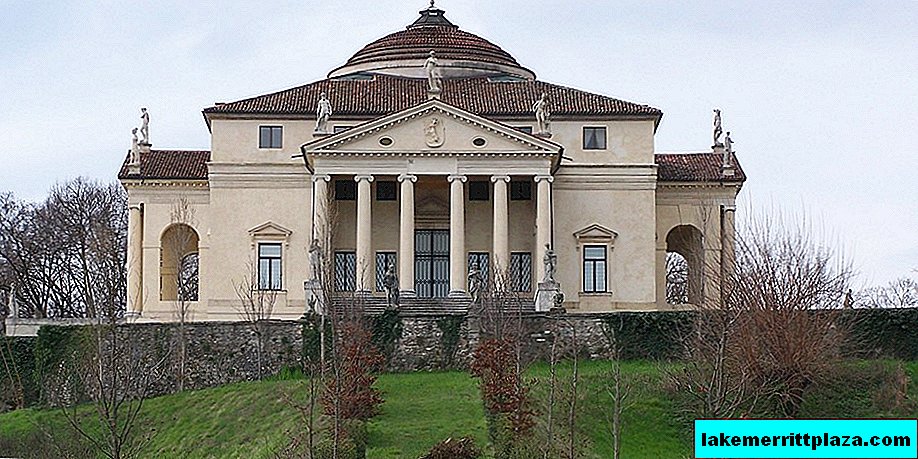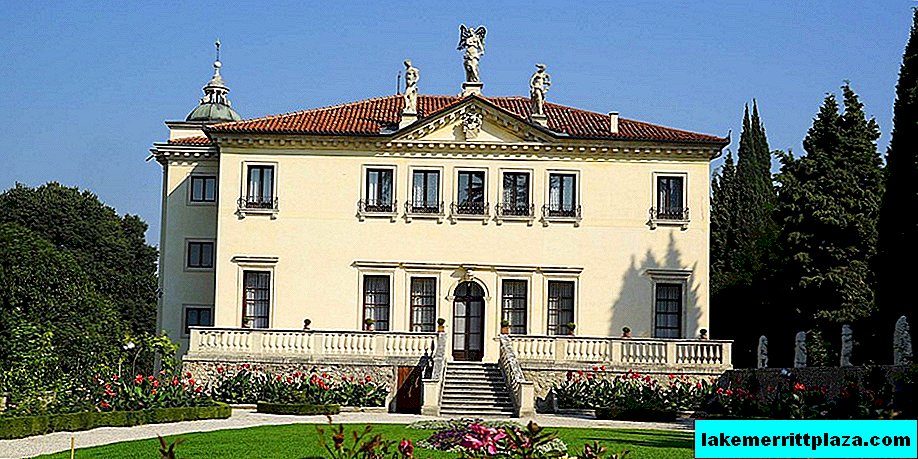Vicenza (Vicenza) - a city in the region of Venice (Venezia), the Veneto region, the center of the province of Vicenza, located among the hills at the confluence of the river Retrone (Retrone) in Bacchiglione. Vicenza has developed the textile and machine-building industries, as well as the production of jewelry made of precious metals and stones. It is here that the clothing of such world-famous brands as Gas Jeans, Dainese and Bottega Veneta is made.

In the field of art and tourism, the architectural masterpieces of Andrea Palladio (Andrea Palladio) are known, forming a complex that is under the protection of UNESCO.
City `s history
The results of excavations by archaeologists indicate that the first residential buildings in these parts appeared in the XI-VII centuries BC. After being incorporated into the Roman Empire (l'impero romano), the territory expanded and was decorated with temples, private country houses, public buildings, streets were built, water pipelines were laid.
A fragment of the House of the Patricians (Casa patrizi) on Piazza Duomo has survived to this day. In the suburbs of Lobbia, you can explore the remaining parts of the water supply system. Later periods include the construction of Christian churches:
- Basilica Felice and Fortunatto (Basilicadei Santi Felice e Fortunato);
- San Giorgio;
- Abbey of St. Augustine (Abbazia di sant'Agostino).
The pages of medieval history of Vicenza are connected with the activities of the Scaliger family, who ruled these places in 1262-1387. Later, from the beginning of the XV to the end of the XIII century, the area was part of the Republic of Venice (Serenissima Repubblica di Venezia).
In the XVI century there were buildings made by the master Andrea Palladio:
- Basilica of Palladiana (Basilica Palladiana);
- Signoria Square (Piazza dei Signori);
- Teatro Olimpico Theater;
- Villa Capra (VillaCapra) and others.
Sights
What sights to see in Vicenza in one day?
Palladian Basilica
Drawings and a construction plan were developed in 1549. Presenting the vivid stylistic features of Gothic architecture in urban design, the basilica is interesting for galleries and a colonnade decorating the facade.
Palazzo Kyerikati

The Palazzo Chiericati was built by Palladio in the years 1550/80 for a private customer. An unusual solution is two wings resembling wings that are slightly folded back and curved. On the front side, two overlapping colonnades and sculptural images of gods and heroes on the roof attract attention.
Olympic Theater
The project was developed by Palladio in 1580, and the building was completed after his death by Vincenzo Scamozzi. This theater was the first in Europe to have a roof. The scene, which became the prototype of the modern, was also modernized. The first performance took place in March 1585, and the theater is still operating.
Pigafetta House

The house of Pigafetta (Palazzo Pigafetta) was built in the years 1440-1481 for the famous traveler Antonio Pifagetta (Antonio Pigafetta), who kept an on-board diary on the ship that circumnavigated Fernando de Magallanes.
The magnificent building is a classic example of the Gothic style in architecture. Particularly significant is the facade, decorated with ornaments, heavy carved doors, the coat of arms of the clan and the motto of the Pythagetta clan.
Villa Rotonda

Villa Rotonda (La Rotonda), which has been under construction since 1566, has a cruciform shape with four facades decorated with colonnades. In the center there are circular arches, inside there is a central space in the shape of a circle.
The value of the Rotunda is in the preserved frescoes in the interior. Later it began to be called by the name of the new owners - Villa Capra.
Villa Valmarana

More often, Villa Valmarana, built by Palladio for the Valmarana family, is called the "House of the Dwarves" ("La casa degli gnomi") because of the sculptural images of dwarfs decorating the facade.
When the villa was built, these dwarfs were the decorations of the park. The interior is represented by a mural by Giambattista e Giandomenico Tiepolo based on ancient myths, biblical legends and the lives of the townspeople of the Enlightenment (L'educazione).
Representatives of this genus still live in an old house.
Palazzo Leoni Montanari
The Palazzo Leoni Montanari was designed in 1678, and at the beginning of the XVIII century, bright features of baroque architecture, decor that reproduces the plots of Greek and ancient Roman myths, were supplemented in the process of rebuilding by neoclassical style elements.
The palace exhibits a private collection of works by artists of Venice of the 18th century and icons by masters of Ancient Russia of the 13th century, exported from Russia.
La Loggia

The Palace of La Loggia del Capitanio, located on the Piazza dei Signoria, was designed and built by Palladio in 1565-1571. It was intended to receive senior officials of the Republic of Venice. The sculptural works of Lorenzo Rubini (Lorenzo Rubini) adorn the palace, which hosts city council meetings.
Basilica of Felice and Fortunato

The Basilica of Felice and Fortunato - serves as an example of architectural art of the X century. According to the custom of that time, it was built by Christians on the basis of the destroyed pagan temple. The name is associated with two Christian saints whose relics rest here.
Over the course of a century, the building was destroyed several times during the hostilities and restored again, and in 983 it was handed over to the monks of the Order of St. Benedict (Di San Benedetto).
Church of Our Lady

The Temple of Our Lady of Monte Berico (Santuario Della Madonna Di Monte Berico) is a combination of features of several architectural directions. It was founded in 1428 and built in compliance with the principles of Gothic architecture. In 1703, Carlo Borella (Carlo Borella) was attached to another church with elements of the Baroque and classic styles. Even later, in 1826, according to the drawings of Antonio Piovene, a belfry appeared. The temple is decorated with works of famous Italian masters. One of them is the "Supper of St. Gregory the Great" by Paolo Veronese.
Museums
In Vicenza you can visit several museums of different orientations:
- Santa Corona Museum of Nature and Archeology (Il museo naturalistico e archeologico di Santa Corona), opened in 1991, introducing the flora and fauna of the province and its geological and excavation history;
- The Museum of Resistance (Museo Della Resistenza), which presents a sketch of the heroic pages of the history of these places and its battles for freedom and independence throughout the ages;
- The Diocesan Museum (Museo diocesano), which opened in 2005, presents a rich collection of utensils of Christian churches;
- The Palladio Museum (Museo Palladio), which opened in 1997, exhibits models of the work of the great master and documents about his life and work;

- The Museum of Fine Arts in the Palazzo Thiene (Palazzo Thiene) is famous for paintings of the XV-XIX centuries, ancient books, etc.
The art gallery, housed in the Palazzo Kierikati since 1855, presents a collection of paintings and sculptures by masters from different eras, as well as an exhibition of coins and works by famous engravers. Many paintings were acquired by the gallery at the expense of donors. So the canvases of Tintoretto, Antonin Van Dyck, Sebastiano Ricci and others appeared here. Among the unique treasures of the gallery are drawings by Andrea Palladio.
Hotels
Vicenza has more than 80 accommodation options marked by positive reviews from tourists from different countries.
3 stars
The 3-star hotels offer comfortable rooms with a seating area and modern appliances. For guests, most options offer a breakfast buffet, local dishes.
Hotel doge

Hotel Doge is surrounded by a garden and is located in the historic city center and has its own parking. The rooms are equipped with household appliances, split systems, televisions, ozonizers, cosmetics are prepared for guests. The hotel invites you to free fitness classes in the modern gymnasium, as well as in the pool and on SPA-procedures.
Pets are welcome here.
Hotel verdi

Located in modern city blocks, Verdi Hotel offers air-conditioned rooms with balconies, TVs and other amenities. The hotel has a business center, a salon for wellness treatments, a swimming pool, a gym for fitness. All guests can use bicycles, free internet access, parking. The hotel accommodates children under 6 years old free of charge.
4 stars
The peculiarity of 4 star hotels is their location in the very center of the old town at a distance of 100-300 meters from the main monuments of history and culture.
G boutique hotel

G Hotel Boutique Hotel, located in the historical center within walking distance of the main attractions, invites you to stay in rooms with original interior design, modern appliances, air conditioning.
The rooms are decorated with luxurious natural wood or carpet flooring. Some have balconies overlooking the main square of Vicenza. For guests discounts are available at a nearby tennis court, and a rental car service is available. The hotel has all conditions for guests with young children and disabled people.
Antico Hotel Vicenza

Antico Vicenza occupies a building of the beginning of the 20th century in the very center, from the terrace of which a panorama of the city quarters opens. Comfortable rooms have balconies, modern appliances and comfortable bathrooms, minibars. Here guests with children and pets are welcome.
Apartments and B&B
The apartments, located 5-10 minutes from the beach, provide leisure facilities in the rooms of a high level of comfort in buildings surrounded by greenery.
B&B Vicenza San Rocco

Hotel Vicenza San Rocco is located in the city center and 8 minutes from the beach area. For guests there are free parking spaces.
The hotel has a beautiful spacious terrace where you can have breakfast in warm weather and at the same time enjoy the garden around the hotel.
Children under 3 years old are welcome here. Pets are welcome.
Relais Villa Gozzi B&B

Set in a garden surrounded by beautiful countryside, Relais Villa Gozzi is just a 10-minute drive from the historic center of Vicenza. The rooms in the rooms with balconies, fireplaces and wide windows to the garden are stylized as a rustic house, guests relax on four-poster beds. Each room has air conditioning, household appliances, beds with orthopedic mattresses.
Guests can use free Wi-Fi, bicycles, table tennis equipment, free parking spaces. The hotel has facilities for guests with disabilities.
How to get there
You can come to Vicenza from Venice. Milan, Padua, Verona.
You can get from Venice by rail in 45 minutes by buying a ticket worth about 9 €. Information is presented on the website trenitalia.com
By bus to Vicenza you can get from Milan, Bologna, Ferrara, Trieste, Bergamo, Turin, Rome. The fare is from 5 euros. You can order tickets and find detailed schedule information on the flixbus.ru website.

If you hit the road in a rented car, you can get there in 60 minutes, spending about 15 € of fuel.








